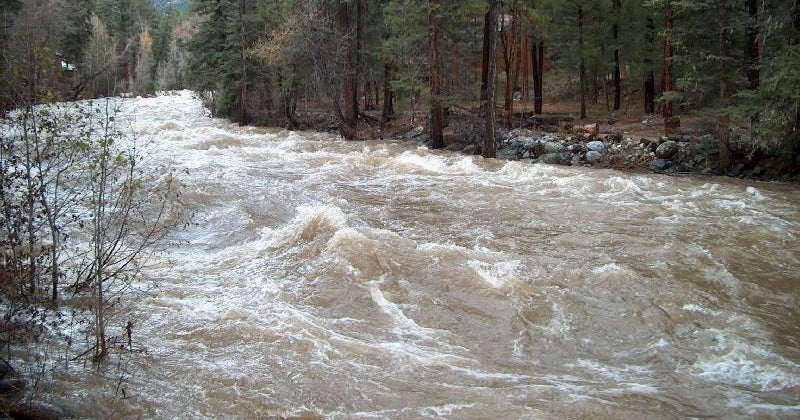BAYFIELD — Hundreds of La Plata County residents were forced to evacuate their homes Saturday after a storm dropped 4 inches of rain in 48 hours, causing creeks to swell and flood communities north of Vallecito Reservoir.
Emergency responders evacuated about 390 homes in response to the flooding, saying that up to 100 homes have been impacted, according to La Plata County and the Upper Pine River Fire Protection District. No deaths or major injuries have been reported, according to Sarah Jacobson, the public information officer for the incident.
“Typically (for) the water gages on Vallecito Creek, high water is under 3,000 cubic feet per second,” Jacobson said. “This morning it was at 6,800 cubic feet per second.”
Vallecito Creek peaked at about 7,000 cubic feet per second or almost 6 feet deep, according to early estimates from the National Weather Service in Grand Junction. Jacobson estimated that about 40 to 50 homes were damaged.
One resident near Vallecito Lake, who declined to share his name, said the flood happened quickly in his yard, rapidly replacing the peaceful, rainy scene with flooding that reached his crawlspace.

The surge of water carried a hot tub, kayaks and trees into rivers in the area, according to Jacobson and local reports.
“We’ve got lots of small, ancillary structures that have washed down. Trees have been washing down,” Jacobson said. “It’s kind of unprecedented.”
This amount of steady rainfall is out of the norm for this area, Erin Walter, a service hydrologist for the National Weather Service in Grand Junction, said. (The weather service staff are working without pay during the federal shutdown because of their role in protecting public safety.)
“When we were looking at the amount of moisture in the atmosphere, it was 300% of normal,” she said.
In response, the weather service issued a flood watch for southwestern Colorado, the San Juan Mountains and northward across the Western Slope. As the storm moves east, more flooding is expected along the San Juan River and in Pagosa Springs, where parts of the town were being evacuated as of Saturday evening. The Rio Blanco and Navajo rivers are also rapidly rising.
“This is a lot of moisture, not only for this time of year but in general,” Walter said. “These are really high amounts for our area to see as rainfall.”
More rain is expected Saturday night, and evacuees have been instructed to check in at Bayfield High School before 8 p.m. The facility is also available for anyone who needs to stay overnight, offering pizza, salad, coffee and cots to evacuees.
About 10 people planned to stay overnight as of early Saturday evening, according to the American Red Cross volunteers.
Evacuating Vallecito
Residents got evacuation notices on their phones with instructions to check in at Bayfield High School. About 57 people had checked in as of 4:40 p.m., Jacobson said.
“Evacuees are encouraged to check in just so that we can find people if we need to. If we need to notify them about their residence or anything they’re easier to find,” she said.
The flooding made some evacuation routes impassable, according to the Upper Pine River Fire Protection District’s Facebook page.
Evacuees should not try to use County Road 501A from Elkhorn to Five Branches because the bridge over the Pine River was damaged and cannot support vehicle traffic. County Road 501 was also closed at the Vallecito Creek Bridge because of damage. The main open evacuation route is down parts of County Road 501 and County Road 500 leading to Bayfield High School, where the official evacuation center is located, according to the fire protection district.

County road and bridge staff were stationed at bridges north of Vallecito Reservoir to try to clear debris to avoid damage to the bridges, Jacobson said.
It was not clear how long the evacuations would last as of Saturday afternoon. Emergency responders were keeping an eye on the forecast, Jacobson said.
“It’s not over,” she said. “It’s hard to say. We have rain forecasted for the rest of the week as well.”
The weather service is expecting one-half inch to 1 inch of precipitation in spotty showers over the next 48 hours, Walter said. Earlier estimates were closer to 2 inches.
The last time the river rose to this level was 1970, when it hit 7,050 cfs. It’s not yet clear if this weekend’s flows will surpass the historic record based on the preliminary data, Walter said.
“Unfortunately, there’s been some issues with the USGS site, and I have not been able to access those gauges through their website,” Walter said. “I believe most of those folks are furloughed. We don’t have that information right now.”
Residents and locals should stay out of the area, avoid driving through running water and be careful driving through mud.
“There’s been some debris washing over roads. (We’re) asking people to be really careful when they’re on the public roads,” Jacobson said.

More rain on the Western Slope
Rain fell on a large swath of the Western Slope, but the San Juan Mountains in southwestern Colorado were under the firehose of moisture coming from the Pacific Ocean, Walter said.
The Grand Valley also saw about 2 inches of rain, but the precipitation tapered off in northern Colorado.
Another surge of moisture is headed to the San Juan Mountains, including the Vallecito area, and southwestern Colorado on Monday and Tuesday, when the remnants of another tropical storm will pass over the area.
It doesn’t look as intense or out of the norm as this weekend, but it will bring additional moisture to the area, Walter said.
The weather service is keeping an eye on the scars from this summer’s wildfires, like Stoner Mesa in the San Juan Mountains, the Lee fire scar in Rio Blanco County, the South Rim fire scar near Montrose, and others on the Western Slope.
“We are concerned about our burn scars,” Walter said. “We haven’t heard of any reports yet of any slides, but with this prolonged and steady rainfall, if we do see any more intense thunderstorms it could easily trigger a debris flow.”
This will help with current drought conditions. It does help to saturate soils before winter because that moisture will be locked into frozen soils. In spring, more snowmelt could reach streams because the soils are already more saturated.
“One storm won’t get us out and solve all of our issues, but it does certainly help the soil moisture,” Walter said.
This is a breaking news story that will be updated.
Source link

